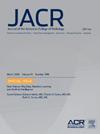Comparing Artificial Intelligence and Traditional Regression Models in Lung Cancer Risk Prediction Using A Systematic Review and Meta-Analysis
IF 4
3区 医学
Q1 RADIOLOGY, NUCLEAR MEDICINE & MEDICAL IMAGING
引用次数: 0
Abstract
Purpose
Accurately identifying individuals who are at high risk of lung cancer is critical to optimize lung cancer screening with low-dose CT (LDCT). We sought to compare the performance of traditional regression models and artificial intelligence (AI)-based models in predicting future lung cancer risk.
Methods
A systematic review and meta-analysis were conducted with reporting according to Preferred Reporting Items for Systematic Reviews and Meta-Analyses guidelines. We searched MEDLINE, Embase, Scopus, and the Cumulative Index to Nursing and Allied Health Literature databases for studies reporting the performance of AI or traditional regression models for predicting lung cancer risk. Two researchers screened articles, and a third researcher resolved conflicts. Model characteristics and predictive performance metrics were extracted. The quality of studies was assessed using the Prediction model Risk of Bias Assessment Tool. A meta-analysis assessed the discrimination performance of models, based on area under the receiver operating characteristic curve (AUC).
Results
One hundred forty studies met inclusion criteria and included 185 traditional and 64 AI-based models. Of these, 16 AI models and 65 traditional models have been externally validated. The pooled AUC of external validations of AI models was 0.82 (95% confidence interval [CI], 0.80-0.85), and the pooled AUC for traditional regression models was 0.73 (95% CI, 0.72-0.74). In a subgroup analysis, AI models that included LDCT had a pooled AUC of 0.85 (95% CI, 0.82-0.88). Overall risk of bias was high for both AI and traditional models.
Conclusion
AI-based models, particularly those using imaging data, show promise for improving lung cancer risk prediction over traditional regression models. Future research should focus on prospective validation of AI models and direct comparisons with traditional methods in diverse populations.
比较人工智能和传统回归模型在肺癌风险预测中的应用:系统综述和荟萃分析。
目的:准确识别肺癌高危人群是优化低剂量CT肺癌筛查的关键。我们试图比较传统回归模型和基于人工智能(AI)的模型在预测未来肺癌风险方面的性能。方法:根据PRISMA指南进行系统评价和荟萃分析。我们检索了MEDLINE、Embase、Scopus和CINAHL数据库,寻找报告人工智能或传统回归模型预测肺癌风险的研究。两名研究人员筛选文章,第三名研究人员解决冲突。提取模型特征和预测性能指标。使用PROBAST工具评估研究的质量。一项meta分析基于受试者工作特征曲线(AUC)下的面积评估了模型的识别性能。结果:140项研究符合纳入标准,包括185项传统模型和64项基于人工智能的模型。其中,16个人工智能模型和65个传统模型已经进行了外部验证。人工智能模型外部验证的合并AUC为0.82(95%置信区间[CI], 0.80-0.85),而传统回归模型的合并AUC为0.73 (95% CI, 0.72-0.74)。在亚组分析中,包含LDCT的AI模型的合并AUC为0.85 (95% CI, 0.82-0.88)。人工智能和传统模型的总体偏倚风险都很高。结论:基于人工智能的模型,特别是那些使用成像数据的模型,比传统的回归模型更有希望改善肺癌风险预测。未来的研究应侧重于对人工智能模型的前瞻性验证,并在不同人群中与传统方法进行直接比较。
本文章由计算机程序翻译,如有差异,请以英文原文为准。
求助全文
约1分钟内获得全文
求助全文
来源期刊

Journal of the American College of Radiology
RADIOLOGY, NUCLEAR MEDICINE & MEDICAL IMAGING-
CiteScore
6.30
自引率
8.90%
发文量
312
审稿时长
34 days
期刊介绍:
The official journal of the American College of Radiology, JACR informs its readers of timely, pertinent, and important topics affecting the practice of diagnostic radiologists, interventional radiologists, medical physicists, and radiation oncologists. In so doing, JACR improves their practices and helps optimize their role in the health care system. By providing a forum for informative, well-written articles on health policy, clinical practice, practice management, data science, and education, JACR engages readers in a dialogue that ultimately benefits patient care.
 求助内容:
求助内容: 应助结果提醒方式:
应助结果提醒方式:


